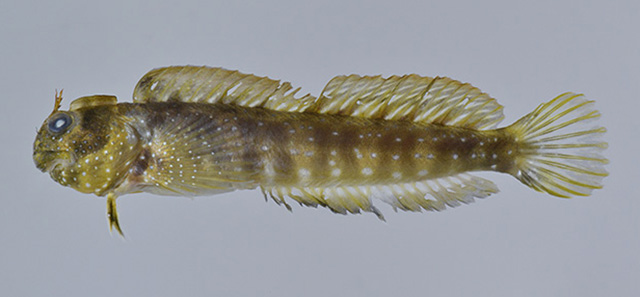| Blenniidae (Combtooth blennies), subfamily: Salariinae |
| 9 cm TL (male/unsexed) |
|
reef-associated; marine; depth range 0 - 6 m |
| Western Pacific: South China Sea. |
|
Dorsal spines (total): 13-13; Dorsal soft rays (total): 18-20; Anal spines: 2-2; Anal soft rays: 18-21. Head and body greyish brown with small white spots; median fin with white dots. Dorsal fin deeply notched; segmented caudal rays usually 13-14, branched middle 6-9; pinnately branched supraorbital tentacle; lacking nape cirri; posterior rim of anterior nostril with small cirrus, typically unbranched; upper and lower lip margins smooth; with occipital crest (higher in males); last dorsal ray and caudal peduncle connected by membrane; elongate body, depth at anal-fin origin ca. 7.7-7.9 in SL. Maximum size to 9 cm TL (Ref. 90102). |
| Adults inhabit exposed rocky shores (Ref. 90102). Oviparous. Eggs are demersal and adhesive (Ref. 205), and are attached to the substrate via a filamentous, adhesive pad or pedestal (Ref. 94114). Larvae are planktonic, often found in shallow, coastal waters (Ref. 94114). |
|
Least Concern (LC); Date assessed: 27 March 2009 Ref. (130435)
|
| harmless |
Source and more info: www.fishbase.org. For personal, classroom, and other internal use only. Not for publication.
